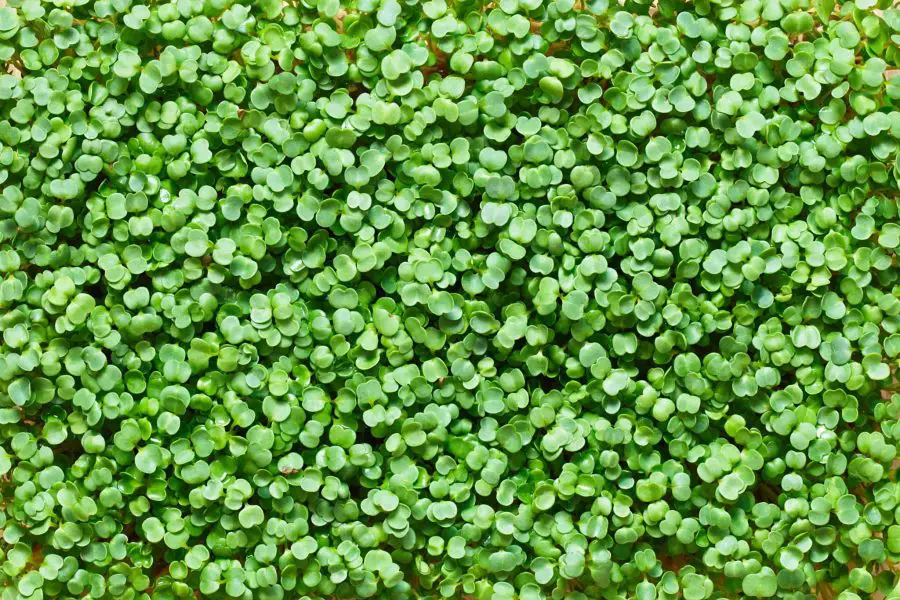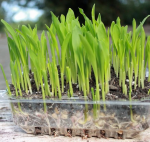This post contains affiliate links. If you buy something from one of our links we may earn a commission. Thanks

Arugula microgreens are a delicious and nutritious addition to any salad or sandwich. In this blog post, we will show you how to grow arugula microgreens in 7 easy steps.
Key Takeaways
• Growing Arugula Microgreens involves a simple 7-step process suitable for both beginners and experienced gardeners.
• Initially, gather essential materials like arugula seeds, growing trays, and a suitable growing medium like coco coir or potting soil.
• Following this, spread the seeds on the moistened soil, cover them lightly, place the container in a well-lit area, and maintain a consistent watering schedule.
• Harvest the microgreens when they are about 1-3 inches tall, typically in 7-14 days.
They are also incredibly easy to grow, making them a popular plant. So, whether you are a beginner gardener or an experienced green thumb, you can easily follow these instructions and have a bountiful harvest of arugula microgreens in no time.
Here is some more on how to grow microgreens at home you might like.
What Are Arugula Microgreens?
Arugula microgreens are the young shoots of the arugula plant and are typically harvested when they are about 7-14 days old.
Because of its fast growth and unique taste it is one of the most popular microgreens.
The plant is also known as garden rocket by some and it actually grows wild in some parts of the Mediterranean region.
Disclaimer: I am not a physician and don’t play one on TV either. The material on this site is not a substitute for professional medical advice, diagnosis, or treatment. Always seek a physician’s advice before using any information you find on this website to treat or prevent any condition.
Because they are so young, microgreens are packed with nutrients and vitamins. Arugula microgreens in particular are high in vitamins C and K, as well as calcium, potassium, and iron.
They also contain a variety of phytochemicals and antioxidants that can have health benefits. Some potential benefits of eating arugula microgreens include improved heart health, better bone health, and a strengthened immune system.
Additionally, because microgreens are so young, they are often more flavorful than fully-grown arugula, so they can add a tasty and nutrient-rich boost to salads and other dishes.
Arugula (American English) or rocket (Commonwealth English) (Eruca vesicaria;… is an edible annual plant in the family Brassicaceae used as a leaf vegetable for its fresh, tart, bitter, and peppery flavor. https://en.wikipedia.org/wiki/Eruca_vesicaria
Arugula Microgreens Benefits
Arugula microgreens are a nutrient-dense food, with a high concentration of vitamins and minerals. A serving of arugula microgreens (about 1 cup) contains:
Vitamin C: 22% of the daily recommended value
Vitamin A: 26% of the daily recommended value
Vitamin K: over 100% of the daily recommended value
Calcium: 4% of the daily recommended value
Iron: 6% of the daily recommended value
Potassium: 4% of the daily recommended value
Manganese: 6% of the daily recommended value
Additionally, arugula microgreens are a good source of antioxidants, which can help protect the body against oxidative stress and disease.
They are also low in calories and fat, making them a healthy choice for those looking to manage their weight.
What’s The Difference Between Arugula And Arugula Microgreens?
Arugula and arugula microgreens are actually the same type of plant, but they are at different stages of growth.
Arugula is a type of plant with leafy greens that is commonly used in salads and other dishes. It has a slightly spicy flavor and is known for its distinctive taste.
Arugula microgreens, on the other hand, are very young arugula plants that are harvested just a few weeks after they are germinated.
They are smaller and a little bit more delicate than mature arugula leaves, and they have a more intense flavor.
What does arugula taste like?
Arugula has a slightly spicy and nutty flavor. Some people describe it as having a mustard-like or peppery taste. It is often used in salads and other dishes to add a burst of flavor.
Because of their small size, arugula microgreens are often used as a garnish or added to dishes as a flavorful and nutritious topping.
In short, the main difference between arugula and arugula microgreens is their size and flavor.
Arugula microgreens are smaller and have a more intense flavor, while mature arugula leaves are larger and have a milder flavor.
How To Grow Arugula Microgreens In 7 Easy Steps
Before you start growing arugula you need to gather your materials together. You will need arugula microgreen seeds, growing trays, and a growing medium like potting soil or coco coir.
If you are a beginning gardener it might be easiest to start with a kit. So if you want to skip gathering your growing supplies separately you can get started by buying an arugula starter kit.
If you prefer to grow your arugula and start from scratch here are the seven steps for growing arugula microgreens:
How To Grow Arugula Microgreens In 7 Easy Steps
1.Get your arugula seeds
Start by obtaining arugula seed packets from a reputable supplier or you can buy them online. Unlike some other vegetable seeds, there really aren’t any special varieties of arugula to recommend.
2. Prepare the Growing Medium
Depending on how much space you have available, select one or two shallow containers for growing your microgreens.
Using a 2 tray system will allow bottom watering of your arugula seedlings. This is the best method of watering microgreens.
One container should have drainage holes and growing media in it and the other should be empty.
You will want to place water in one and set the tray with the holes inside it to bottom water your soil.
Fill these with a moisture-retaining soil mix suitable for germinating seeds such as potting mix, coconut coir, sphagnum moss, or vermiculite/perlite mixture.
 You can use recycled food containers or clamshells for microgreen trays as long as they are clean.
You can use recycled food containers or clamshells for microgreen trays as long as they are clean.
For best results prepare a 1020 seed propagation tray or container with a growing medium, such as potting soil or a soilless mix, or coconut coir.
3. Plant the Seeds
Spread out your arugula seeds over the surface of the moistened soil and lightly press the tiny seeds into place using your fingers or a small spoon.
Dont presoak your seeds. It is much easier to sow dry arugula seed.
Sprinkle the seeds over the surface of the growing medium, making sure to distribute them evenly and about 1/4 inch apart.
4. Cover the Seeds
To ensure that your arugula microgreens get adequate moisture, cover them with a thin layer of moistened soil.
Water the seeds gently, by misting them using a spray bottle. The seeds should be moist but not waterlogged.
Avoid giving them too much water it can cause mold issues or fungal diseases.
5. Place in a Sunny Spot
Place the container in an area with plenty of sunlight, such as a south-facing windowsill.
Place the tray or container in a location that receives indirect sunlight and has a consistent temperature of around 70-75 degrees Fahrenheit.
During the winter months in North America, you may not have enough natural lighting to grow microgreens. You need at least 4-6 hours of direct sunlight.
So most likely you will need to provide supplemental lighting. Here is an LED grow light that will work well:
6. Water Regularly
Keep the soil moist but not saturated by watering lightly every day. Mist watering is a beneficial way to help keep the surface of the soil evenly moist while preventing waterlogging. You can also bottom water your baby plants.
Keep the seeds moist by watering them regularly, making sure to not let the growing medium dry out completely, and also avoid overwatering your seedlings. When they are very small they can’t use a lot of water.
7. Harvest when Ready
Your arugula microgreens will be ready to harvest after about 7-14 days and 1-3 inches tall.
After about 7-10 days, the arugula microgreens should be ready to harvest but you can begin by starting to thin them out and letting some plants get larger.
Simply cut them off at the base of the stems, using scissors or a sharp knife.
If you want to extend your harvest try removing just single outer leaves and leaving the top of the stem intact.
By following these steps, you can easily grow a healthy crop of your own arugula microgreens in no time.
Not only are they incredibly delicious and nutritious, but growing them is also a fun and rewarding experience for any gardener.
So don’t hesitate to get started on growing your own arugula microgreen garden today.
How Do You Store Arugula Microgreens?
Arugula microgreens can be stored in the refrigerator in a container or plastic bag that has ventilation holes. It’s important to keep them dry and away from moisture to prevent spoilage.
To extend their shelf life, you can place a paper towel in the container to absorb excess moisture.
You can also place the container in the crisper drawer of your refrigerator to keep the microgreens fresh for as long as possible.
It’s best to use the microgreens within a week for the best flavor and texture. Here is more info on how to store microgreens.
Arugula FAQs
Growing arugula microgreens might lead to a garden of queries. Our FAQ section is tailored to unravel the common questions budding from the seed of curiosity to the leaf of understanding.
From growth timelines to the regrowth potential, jar growing technique to sprouting arugula microgreens, we delve into a series of inquiries ensuring a clear path towards a bountiful harvest.
Each question is nurtured with a well-rounded answer, aiding in a fruitful growing experience.
Q. How long do arugula microgreens take to grow?
A. Arugula microgreens typically take about 7 to 10 days to grow. The exact amount of time it takes for arugula microgreens to grow will depend on a variety of factors, such as the temperature, moisture, and lighting conditions in your growing environment.
To ensure that your arugula microgreens grow quickly and healthily, it’s important to provide them with the right conditions and care.
This can include providing them with plenty of sunlight, watering them regularly, and providing them with the right type of soil or growing medium.
Overall, with the right care and attention, you can expect your arugula microgreens to be ready for harvest in just a few short days.
Q. Do arugula microgreens grow back?
A. Arugula microgreens are typically harvested when they are just a few inches tall and have their first true leaves.
Because they are harvested at such an early stage, they will not regrow once they have been cut.
However, if you have the seeds and suitable growing conditions, you can always plant more arugula microgreens to have a continuous supply.
Q. Can you grow arugula microgreens in a jar?
A. Yes, you can grow arugula microgreens in a jar. Growing microgreens is a fun and easy way to produce fresh, nutrient-rich greens in a small space.
To grow arugula microgreens in a jar, you will need some arugula seeds, a clean glass jar, and a cheesecloth or other porous cover, and a rubber band to hold it in place.
To get started, fill the jar with a few inches of moist soil, then scatter the arugula seeds on top of the soil.
Cover the seeds with a thin layer of soil, then water the seeds gently until the soil is moist. Place the jar in a sunny spot, and water the seeds regularly to keep the soil moist.
In a few days, the arugula seeds will sprout and begin to grow. Once the microgreens are about an inch tall, you can harvest them and enjoy them in salads, or sandwiches, or use them as a garnish.
It is even easier to grow arugula sprouts in a glass jar and just below here is how:
Q. Can you grow arugula microgreen sprouts?
Yes, you can grow arugula microgreen sprouts. To grow arugula microgreens in a jar, you will need some arugula seeds, a clean glass jar, a cheesecloth or other porous cover, and a rubber band to hold it in place.
A. Cover your jar and soak your seeds in water for about 12 hours. Then rinse them out and remove standing water.
Leave the cheesecloth cover on the jar. They will start to sprout in a few days and will be ready to harvest.







